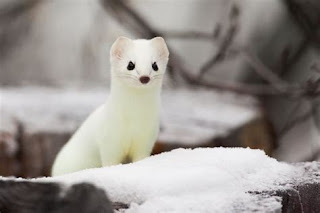Fast Facts: Ermine
The Ermine : Mustela erminea
Description: Also known as a Stoat, the Ermine is a kind of weasel and is part of the Mustelidae family. Measuring around 7-12 inches long, the Ermine's physical characteristics include a long tail, dark eyes, a small triangular nose, an elongated neck, and round ears. In the warmer months of summer, the Ermine is brown with a white belly. In the winter, the Ermine blends into its new surroundings by utilizing a white fur coat. In all seasons, the Ermine's tail is tipped with black.
Habitat: Ermines live in many different areas, but all of them generally have cold climates. Ermines live in habitats ranging from mountains to moors to woodlands. Many of these areas have crevices and nooks where the Ermines can establish dens. Ermine distribution is as varied as their habitats; these creatures can be found in the Arctic, Europe, Canada, Greenland, Russia, and Northern US and China.
Diet: Although they are small, Ermines are skilled hunters and will prey on shrews, mice, and even squirrels. When small mammals like these are scarce, Ermines will switch to a smaller-sized diet of birds, frogs, eggs, and insects.
Behavior: Ermines are nocturnal and hunt during the night. Their sharp claws and agility allow them to take down prey many sizes larger than themselves, including deer. Ermines are solitary creatures, but they're born into large litters with up to 12 members. These large litters are how Ermines learn how to hunt. By play-fighting with their siblings as they grow up, Ermines develop vital skills to attack predators and defend themselves.
Conservation Status: The exact population of the Ermine is unknown; however, they are listed as Least Concern, and the population is said to be abundant and widespread. In the 20th century, and even now, Ermines were hunted for their fur. Although their numbers are stable now, Ermines have faced significant hunting and trapping in their history.
Unique Traits: Unlike some carnivorous species, the Ermine is constantly under the threat of predators such as birds of prey and larger weasels. The Ermine avoids these predators because of its quick reflexes and speeds; Ermines can reach up to 20 miles per hour even on the rough and rocky terrain of their habitats. And as stated above, Ermines' coats change color during different seasons so that they can blend into their environment. The Ermine has developed other adaptations to survive in its frigid environment as well. Its long and slender body allows it to retain heat because of the high surface area to volume ratio. Their slenderness also allows them to burrow into small spaces for warmth and shelter. Finally, Ermines have unique gestation cycles. They breed in the warmer months of summer, but the fertilized egg remains inactive for 8-9 months during the winter so that in the spring, the baby Ermines can be born in spring, which gives them a better chance at survival.




Comments
Post a Comment